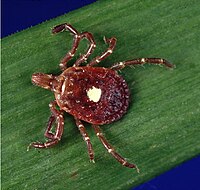
Photo from wikipedia
Bartonella spp. comprise a genus of Gram-negative alphaproteobacteria that are slow growing, fastidious, and facultative intracellular pathogens with zoonotic potential. Immunofluorescent antibody assays (IFAs), Western blot (WB), and enzyme-linked immunosorbent… Click to show full abstract
Bartonella spp. comprise a genus of Gram-negative alphaproteobacteria that are slow growing, fastidious, and facultative intracellular pathogens with zoonotic potential. Immunofluorescent antibody assays (IFAs), Western blot (WB), and enzyme-linked immunosorbent assays (ELISAs), the frequently used modalities for the serological diagnosis of canine and human Bartonelloses, generate numerous false negative results. Therefore, the development of a reliable serodiagnostic assay for Bartonelloses is of clinical and epidemiological importance. Pap31, a heme binding surface protein of B. henselae, is associated with bacterial adhesion and related to bacterial colonization. To our knowledge, B. henselae Pap31 and its fragments (N-terminal (NTD), middle (MD), and C-terminal (CTD) domains) have not been investigated for the serodiagnosis of canine and human Bartonelloses. In this study, we evaluate the diagnostic utility of B. henselae recombinant whole Pap31 (rPap31) and Pap31 fragments by ELISA using sera from 70 dogs (36 Bartonella spp. IFA-positive (naturally infected), and 34 Bartonella spp. IFA- and PCR-negative (control dogs)) and 36 humans (18 Bartonella spp. IFA-positive (naturally infected) and 18 controls)). In the dogs, the area under the curve (AUC) score of recombinant whole Pap31 was 0.714 with a sensitivity of 42% and specificity of 94% at an OD cutoff value of 0.8955. Among the evaluated recombinant Pap31 proteins for the diagnosis of canine Bartonelloses, rPap31-NTD yielded the highest AUC score of 0.792 (95% CI 0.688–0.895) with a sensitivity of 44% and specificity of 100% at a cutoff value of 1.198. In concordance with this finding, rPap31-NTD also had the highest AUC score of 0.747 (95% CI 0.581–0.913) among the Pap31 recombinant proteins for the diagnosis of human Bartonelloses, with 39% sensitivity and 94% specificity at a cutoff value of 1.366. Recombinant whole Pap31 (rPap31) resulted in 72% sensitivity and 61% specificity at a cutoff value of 0.215 for human Bartonelloses. Due to either low sensitivity or questionable specificity, our findings indicate that recombinant Pap31 and the selected fragments may not be appropriate diagnostic targets in detecting anti-Bartonella antibodies in Bartonella-infected dogs and humans. The findings from this study can be used to further assess the antigenicity and immunogenicity of B. henselae Pap31 as a diagnostic target.
Journal Title: Pathogens
Year Published: 2022
Link to full text (if available)
Share on Social Media: Sign Up to like & get
recommendations!